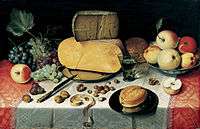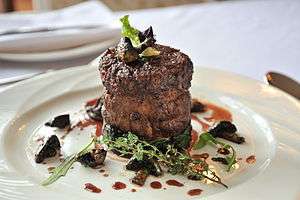Main course
The main course is the featured or primary dish in a meal consisting of several courses. It usually follows the entrée ("entry") course.
| Part of a series on |
| Meals |
|---|
 |
| Meals |
| Components and courses |
| Related concepts |
Usage
In the United States and Canada (except Quebec), the main course is traditionally called an "entrée".[1][2][3] English-speaking Québécois follow the modern French use of the term entrée to refer to a dish served before the main course.
According to linguist Dan Jurafsky, North American usage ("entrée") retains the original French meaning of a substantial meat course.
Serving

The main dish is usually the heaviest, heartiest, and most complex or substantial dish in a meal. The main ingredient is usually meat, fish or another protein source. It is most often preceded by an appetizer, soup or salad, and followed by a dessert. For those reasons the main course is sometimes referred to as the "meat course".
In formal dining, a well-planned main course can function as a sort of gastronomic apex or climax. In such a scheme, the preceding courses are designed to prepare for and lead up to the main course in such a way that the main course is anticipated and, when the scheme is successful, increased in its ability to satisfy and delight the diner. The courses following the main course then calm the palate and the stomach, acting as a sort of dénouement or anticlimax.
See also
References
- "entrée". ENTRÉE | meaning in the Cambridge English Dictionary. Cambridge Dictionary.
- Stewart, Marjabelle Young and Elizabeth Lawrence (1999). Commonsense Etiquette: A Guide to Gracious, Simple Manners for the Twenty-First Century. St. Martin's Press. p. 99. ISBN 9780312242947.
- "You are what you eat — and how you translate the menu". Retrieved 12 September 2017.
Bibliography
- Vergé, Roger (1996). The Main Course. Weidenfeld & Nicolson. ISBN 0-297-83638-2. Retrieved May 25, 2017.